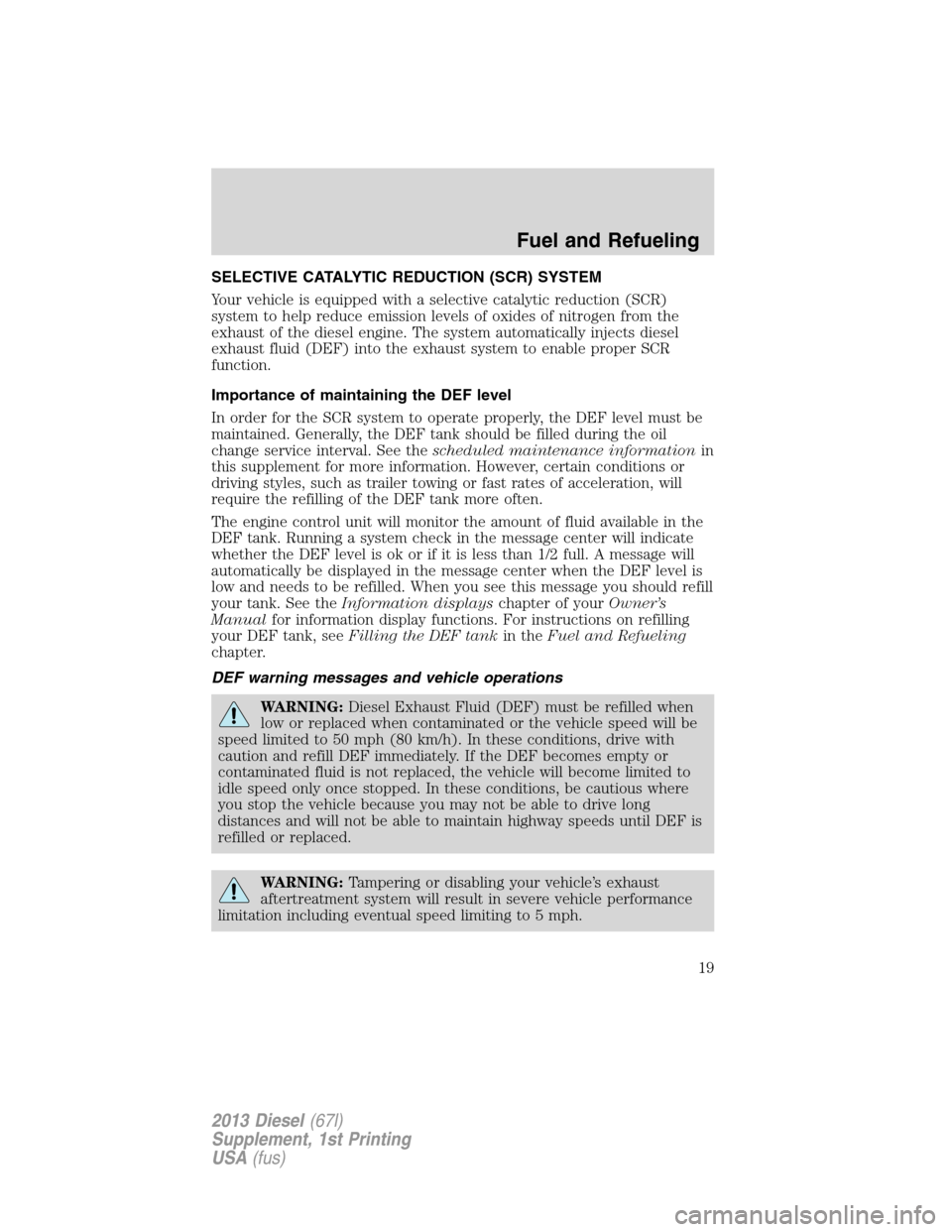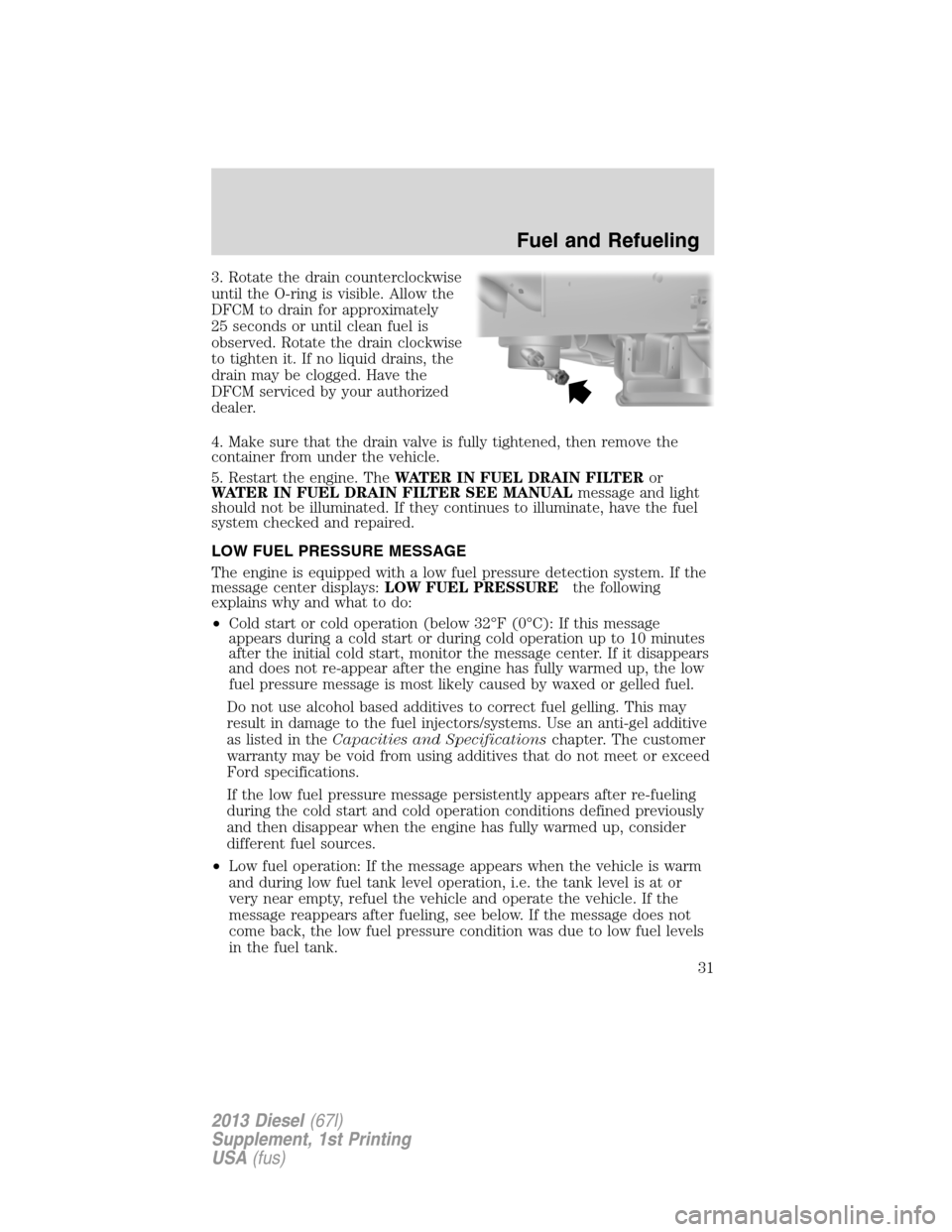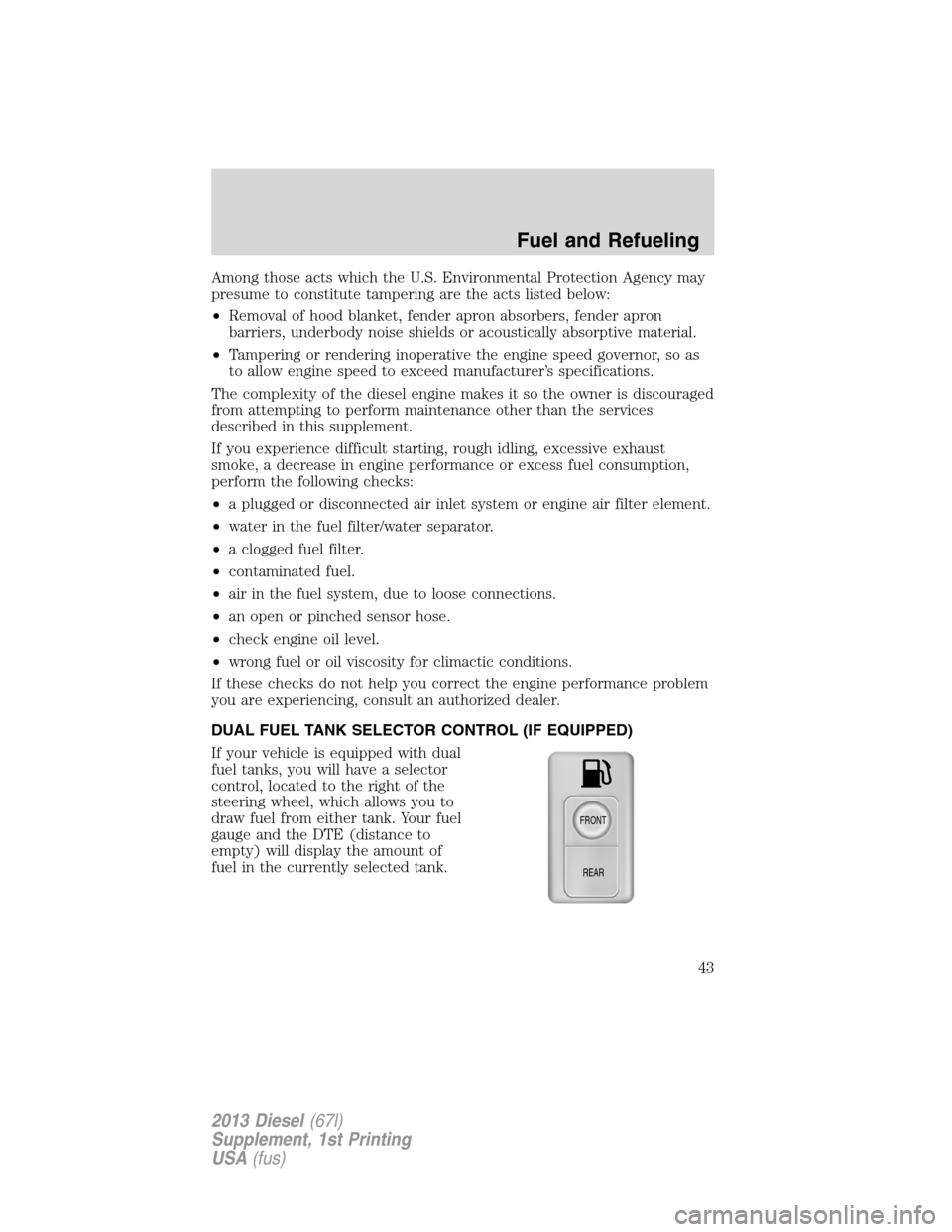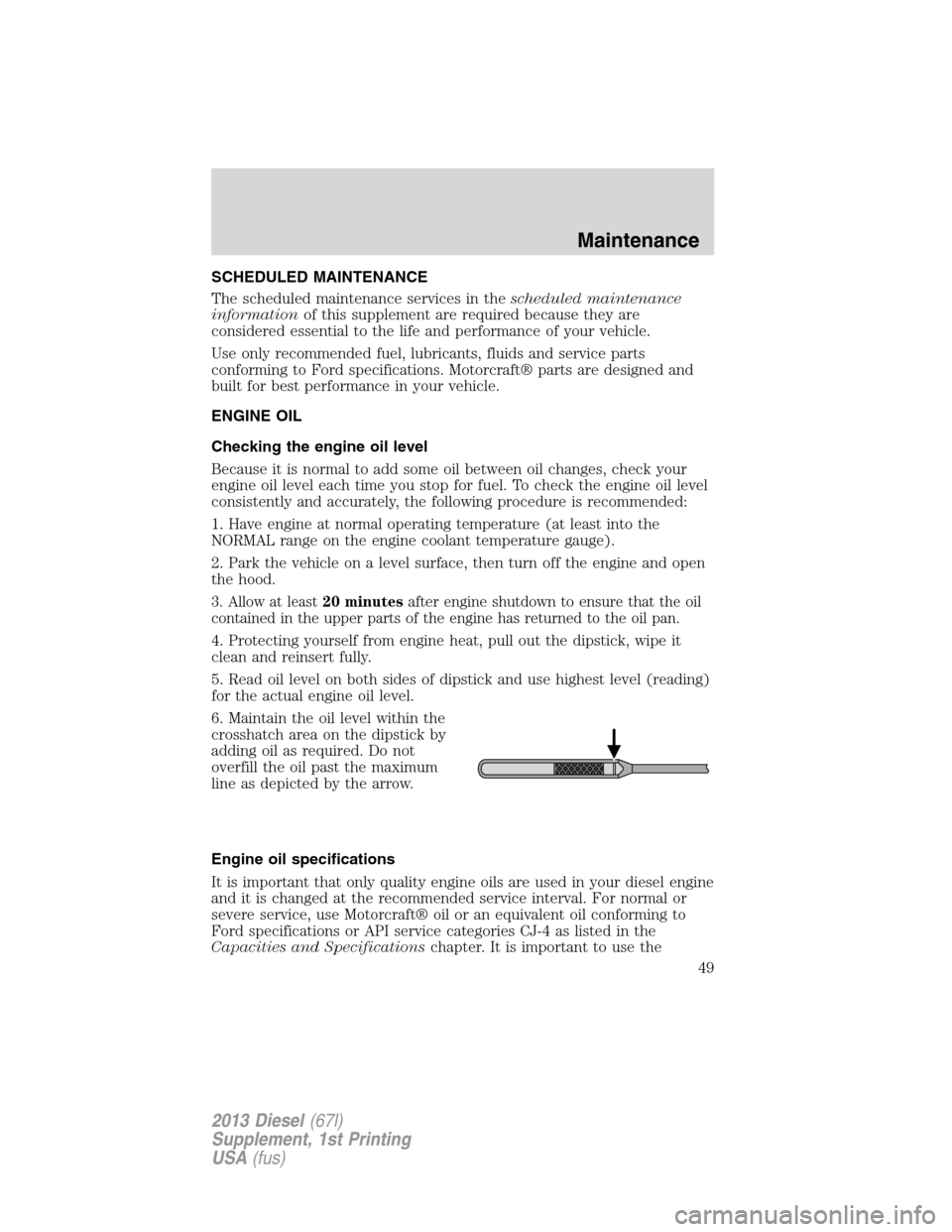2013 FORD SUPER DUTY check engine
[x] Cancel search: check enginePage 4 of 95

BREAKING-IN YOUR VEHICLE
Your vehicle does not need an extensive break-in. Try not to drive
continuously at the same speed for the first 1,000 miles
(1,600 kilometers) of new vehicle operation. Vary your speed to allow
parts to adjust themselves to other parts.
Drive your new vehicle at least 500 miles (800 kilometers) before towing
a trailer. Make sure you use the specified engine oil by checking the
engine oil specification chart underEngine oilin theMaintenance
chapter.
Do not add friction modifier compounds or special break-in oils during
the first few thousand miles (kilometers) of operation, since these
additives may prevent piston ring seating. SeeEngine oilin the
Maintenancechapter of this supplement for more information on oil
usage.
DIESEL ENGINE INFORMATION
The diesel engine fuel system is a pressurized two-stage filtration system
and consists of:
•a frame-mounted diesel fuel conditioner module (DFCM) / primary
filter with an electric fuel pump and water drain,
•an engine-mounted secondary fuel filter,
•a fuel injector for each cylinder (8 total),
•a high-pressure fuel pump,
•a high-pressure fuel rail for each cylinder bank (2 total) and
•numerous high-pressure pipes from the high-pressure pump to the
rails, and rails to the injectors.
The DFCM acts as a primary fuel filter/water separator which removes
both water and impurities from the fuel. The engine mounted filter filters
finer impurities from the diesel fuel. The engine-mounted fuel filter and
the DFCM filter should be changed at the recommended service interval
or when indicated by the information displayLOW FUEL PRESSURE
message. Refer to thescheduled maintenance informationin this
supplement for more information.
The DFCM should be drained at regular intervals (recommended at
every oil change) or when indicated by the information display and water
in fuel indicator light. SeeFuel filter/water separatorin theFuel and
refuelingchapter.
Introduction
3
2013 Diesel(67l)
Supplement, 1st Printing
USA(fus)
Page 12 of 95

In cold weather below 32°F (0°C), the engine may slowly increase to a
higher idle speed if left idling in P (Park). As the engine warms-up, the
engine sound level decreases due to the activation of PCM-controlled
sound reduction features.
If your vehicle is operated in a heavy snow storm or blowing snow
conditions, the engine air induction may become partially clogged with
snow and/or ice. If this occurs, the engine may experience a significant
reduction in power output. At the earliest opportunity, clear all the snow
and/or ice away from inside the air filter assembly. Remove the air
cleaner cover and the pleated paper filter, leaving the foam filter in and
remove any snow or ice. Make sure the foam filter is installed correctly
in place. Remove any debris, snow and/or ice on the foam filter by
brushing the surface with soft brush. Do not use water, solvents, or a
hard brush for cleaning the foam filter.
In order to operate the engine in temperatures of 32°F (0°C) or lower,
read the following instructions:
•Make sure that the batteries are of sufficient size and are fully
charged. Check other electrical components to make sure they are in
optimum condition.
•Use the proper coolant solution at the concentration recommended to
protect the engine against damage from freezing.
•Try to keep the fuel tank full as much as possible at the end of
operation to prevent condensation in the fuel system.
•Make sure you use proper cold weather engine oil and that it is at its
proper level. Also, if necessary, make sure to follow the engine oil and
filter change schedule found under theSpecial operating conditions
section listed in thescheduled maintenance information.
•At temperatures of -10°F (-23°C) or below, it is recommended that
you use an engine block heater to improve cold engine starting.
•If operating in arctic temperatures of -20°F (-29°C) or lower, consult
your truck dealer for information about special cold weather
equipment and precautions.
The following cold weather idling guidelines are recommended:
•Motorcraft® cetane improvers or non-alcohol-based cetane improvers
from a reputable manufacturer may be used as needed.
•Maintain the engine cooling system properly.
•Avoid shutting the engine down after an extensive idling period. Drive
the vehicle for several miles with the engine at normal operating
temperatures under a moderate load.
•Consider using an engine block heater.
•For extended idle times use an approved idle speed increase device.
Starting and Stopping the Engine
11
2013 Diesel(67l)
Supplement, 1st Printing
USA(fus)
Page 20 of 95

SELECTIVE CATALYTIC REDUCTION (SCR) SYSTEM
Your vehicle is equipped with a selective catalytic reduction (SCR)
system to help reduce emission levels of oxides of nitrogen from the
exhaust of the diesel engine. The system automatically injects diesel
exhaust fluid (DEF) into the exhaust system to enable proper SCR
function.
Importance of maintaining the DEF level
In order for the SCR system to operate properly, the DEF level must be
maintained. Generally, the DEF tank should be filled during the oil
change service interval. See thescheduled maintenance informationin
this supplement for more information. However, certain conditions or
driving styles, such as trailer towing or fast rates of acceleration, will
require the refilling of the DEF tank more often.
The engine control unit will monitor the amount of fluid available in the
DEF tank. Running a system check in the message center will indicate
whether the DEF level is ok or if it is less than 1/2 full. A message will
automatically be displayed in the message center when the DEF level is
low and needs to be refilled. When you see this message you should refill
your tank. See theInformation displayschapter of yourOwner’s
Manualfor information display functions. For instructions on refilling
your DEF tank, seeFilling the DEF tankin theFuel and Refueling
chapter.
DEF warning messages and vehicle operations
WARNING:Diesel Exhaust Fluid (DEF) must be refilled when
low or replaced when contaminated or the vehicle speed will be
speed limited to 50 mph (80 km/h). In these conditions, drive with
caution and refill DEF immediately. If the DEF becomes empty or
contaminated fluid is not replaced, the vehicle will become limited to
idle speed only once stopped. In these conditions, be cautious where
you stop the vehicle because you may not be able to drive long
distances and will not be able to maintain highway speeds until DEF is
refilled or replaced.
WARNING:Tampering or disabling your vehicle’s exhaust
aftertreatment system will result in severe vehicle performance
limitation including eventual speed limiting to 5 mph.
Fuel and Refueling
19
2013 Diesel(67l)
Supplement, 1st Printing
USA(fus)
Page 21 of 95

Your vehicle’s message center will display a series of messages regarding
the amount of DEF available. A systems check will display messages
indicating the amount of DEF available (OK or under
1�2full) or will
produce a warning message that displays the mileage (kilometers)
remaining as the fluid in the DEF tank nears empty. For more
information on warning messages, see theInformation Displayschapter
of yourOwner’s Manual.
As the DEF level nears empty, the
DEF warning symbol will be
displayed and chimes will sound
with the messages starting at 500 miles (805 km) remaining before DEF
is depleted. The warning symbol and messages will continue until the
DEF tank is refilled.
Continued driving without refilling will result in the following actions as
required by the California Air Resources Board (CARB) and /or U.S.
Environmental Protection Agency (EPA):
•Within a certain number of miles (kilometers) to empty, speed will be
limited upon vehicle restart. Prior to this occurring a message will
appear in the message center.
•Further vehicle operation without refilling your DEF tank will cause
the engine to enter an idle-only condition. This will only occur upon
vehicle refueling or extended idle and will be indicated by a message
in the message center indicating required actions to resume normal
operation. It is required to add a minimum of 0.5 gallons (1.9L) of
DEF to the tank to exit the idle-only condition, but the vehicle will
still be in the speed limiting mode until the tank is refilled completely.
For either vehicle speed limiting or idle-only condition, normal vehicle
operation will resume when the DEF tank is refilled.
Note:When filling the DEF tank from empty, there may be a short delay
before detecting the increased level of DEF. This must occur before full
power is returned.
Fuel and Refueling
20
2013 Diesel(67l)
Supplement, 1st Printing
USA(fus)
Page 32 of 95

3. Rotate the drain counterclockwise
until the O-ring is visible. Allow the
DFCM to drain for approximately
25 seconds or until clean fuel is
observed. Rotate the drain clockwise
to tighten it. If no liquid drains, the
drain may be clogged. Have the
DFCM serviced by your authorized
dealer.
4. Make sure that the drain valve is fully tightened, then remove the
container from under the vehicle.
5. Restart the engine. TheWATER IN FUEL DRAIN FILTERor
WATER IN FUEL DRAIN FILTER SEE MANUALmessage and light
should not be illuminated. If they continues to illuminate, have the fuel
system checked and repaired.
LOW FUEL PRESSURE MESSAGE
The engine is equipped with a low fuel pressure detection system. If the
message center displays:LOW FUEL PRESSUREthe following
explains why and what to do:
•Cold start or cold operation (below 32°F (0°C): If this message
appears during a cold start or during cold operation up to 10 minutes
after the initial cold start, monitor the message center. If it disappears
and does not re-appear after the engine has fully warmed up, the low
fuel pressure message is most likely caused by waxed or gelled fuel.
Do not use alcohol based additives to correct fuel gelling. This may
result in damage to the fuel injectors/systems. Use an anti-gel additive
as listed in theCapacities and Specificationschapter. The customer
warranty may be void from using additives that do not meet or exceed
Ford specifications.
If the low fuel pressure message persistently appears after re-fueling
during the cold start and cold operation conditions defined previously
and then disappear when the engine has fully warmed up, consider
different fuel sources.
•Low fuel operation: If the message appears when the vehicle is warm
and during low fuel tank level operation, i.e. the tank level is at or
very near empty, refuel the vehicle and operate the vehicle. If the
message reappears after fueling, see below. If the message does not
come back, the low fuel pressure condition was due to low fuel levels
in the fuel tank.
Fuel and Refueling
31
2013 Diesel(67l)
Supplement, 1st Printing
USA(fus)
Page 44 of 95

Among those acts which the U.S. Environmental Protection Agency may
presume to constitute tampering are the acts listed below:
•Removal of hood blanket, fender apron absorbers, fender apron
barriers, underbody noise shields or acoustically absorptive material.
•Tampering or rendering inoperative the engine speed governor, so as
to allow engine speed to exceed manufacturer’s specifications.
The complexity of the diesel engine makes it so the owner is discouraged
from attempting to perform maintenance other than the services
described in this supplement.
If you experience difficult starting, rough idling, excessive exhaust
smoke, a decrease in engine performance or excess fuel consumption,
perform the following checks:
•a plugged or disconnected air inlet system or engine air filter element.
•water in the fuel filter/water separator.
•a clogged fuel filter.
•contaminated fuel.
•air in the fuel system, due to loose connections.
•an open or pinched sensor hose.
•check engine oil level.
•wrong fuel or oil viscosity for climactic conditions.
If these checks do not help you correct the engine performance problem
you are experiencing, consult an authorized dealer.
DUAL FUEL TANK SELECTOR CONTROL (IF EQUIPPED)
If your vehicle is equipped with dual
fuel tanks, you will have a selector
control, located to the right of the
steering wheel, which allows you to
draw fuel from either tank. Your fuel
gauge and the DTE (distance to
empty) will display the amount of
fuel in the currently selected tank.
FRONT
REAR
Fuel and Refueling
43
2013 Diesel(67l)
Supplement, 1st Printing
USA(fus)
Page 47 of 95

FUEL PUMP SHUT-OFF SWITCH
This device stops the electric fuel pump from sending fuel to the engine
when your vehicle has had a substantial jolt.
After an accident, if the engine cranks but does not start, this switch
may have been activated.
This switch is located on the
passenger’s side of the instrument
panel. Open the front passenger
door and remove the small access
panel
The switch has a red button on top
of it.
To reset the switch:
1. Turn the ignition off.
2. Check the fuel system for leaks.
3. If no leaks are apparent, reset the switch by pushing in on the reset
button.
4. Turn the ignition on.
5. Wait a few seconds and return the key to off.
6. Make another check for leaks.
Roadside Emergencies
46
2013 Diesel(67l)
Supplement, 1st Printing
USA(fus)
Page 50 of 95

SCHEDULED MAINTENANCE
The scheduled maintenance services in thescheduled maintenance
informationof this supplement are required because they are
considered essential to the life and performance of your vehicle.
Use only recommended fuel, lubricants, fluids and service parts
conforming to Ford specifications. Motorcraft® parts are designed and
built for best performance in your vehicle.
ENGINE OIL
Checking the engine oil level
Because it is normal to add some oil between oil changes, check your
engine oil level each time you stop for fuel. To check the engine oil level
consistently and accurately, the following procedure is recommended:
1. Have engine at normal operating temperature (at least into the
NORMAL range on the engine coolant temperature gauge).
2. Park the vehicle on a level surface, then turn off the engine and open
the hood.
3. Allow at least20 minutesafter engine shutdown to ensure that the oil
contained in the upper parts of the engine has returned to the oil pan.
4. Protecting yourself from engine heat, pull out the dipstick, wipe it
clean and reinsert fully.
5. Read oil level on both sides of dipstick and use highest level (reading)
for the actual engine oil level.
6. Maintain the oil level within the
crosshatch area on the dipstick by
adding oil as required. Do not
overfill the oil past the maximum
line as depicted by the arrow.
Engine oil specifications
It is important that only quality engine oils are used in your diesel engine
and it is changed at the recommended service interval. For normal or
severe service, use Motorcraft® oil or an equivalent oil conforming to
Ford specifications or API service categories CJ-4 as listed in the
Capacities and Specificationschapter. It is important to use the
Maintenance
49
2013 Diesel(67l)
Supplement, 1st Printing
USA(fus)